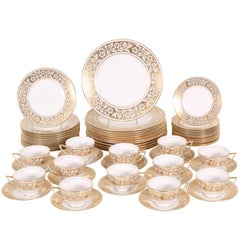English Bone China Regency
Recent Sales
Minton Harmony Pattern English Bone China Dinner Service for 12
By Minton
Located in Bridgeport, CT
12 five piece place settings plus demi tasse saucers:
10.38 inch dinner plates
7.75 inch salad plates
6.25 inch bread and butter plates
5.25 inch wide tea cups
5.5 inch saucers
...
Category
20th Century English Regency Tableware
Materials
Porcelain
Get Updated with New Arrivals
Save "English Bone China Regency", and we’ll notify you when there are new listings in this category.
More Ways To Browse
Georg Jensen Margrethe
Grand Baroque Silver Flatware
Gucci Chopsticks
Gucci Drinking Glasses
Helmut Adler
Horse Knife Rest
Ikea Cutlery
International Silver 1810
International Stainless Flatware Vintage
International Sterling 1810
International Sterling Du Barry
Italian Knives
Jean Claude Flatware
Jens Quistgaard Fjord
Lalique Barsac
Lalique Bourgueil
Lauffer Japan
Lauffer Norway
